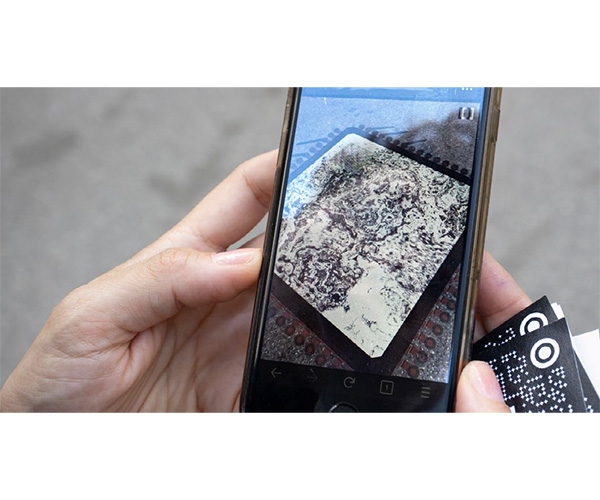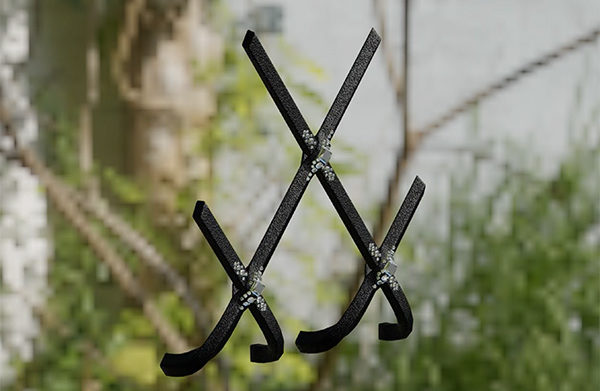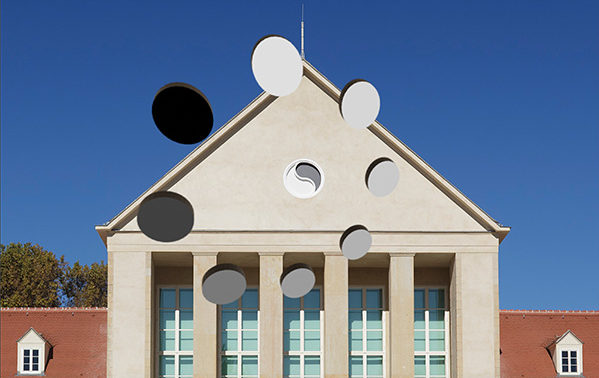Artificial Museum
installations
In collaboration with Daniela Weiss and Jascha Ehrenreich (TheSystemCollective), the artists Alba T Álvarez, Charlotte Eifler, Christiane Wittig, Emma Chapuy, Julie Bader & Paul Schengber, Johann Lucas Lesselt have placed five digital artworks around the Festspielhaus and marked them with QR codes:
Together, the selected artists will give an insight into their working process and the idea and community around the Artificial Museum [ARM] on 21.10. at 19:00. pm.
To be transparent means to be see-through, invisible, penetrable, for what surrounds you. The AR work „thin skin“ deals with the concept of transparency. It is a reflection of the permeability between body and environment and deals with the question of what defines the inside and outside.
Alba T Álvarez is a dancer, performer and artist. She studied dance at the Palucca University of Dance in Dresden and successfully graduated with a Bachelor of Arts in 2018. Since then, she has been working as a freelance artistic author and coauthor for interdisciplinary performative works focussed on the body as subject and object. At the intersection between performance and media art, she is currently beginning to initiate a series of works named „Futur_“, that experiment with the friction between reality and virtuality, the physical and the digital medium.
Human superiority lies in the power to lose oneself in the sensual, so that man is able to create it himself. The sensory object “cherry wood piece” by the artist Christiane Wittig is a relic from her childhood garden. Copied in detail and preserved for eternity.
Christiane Wittig studied media art at the Bauhaus University Weimar, at UNSW Art and Design in Sydney, Australia and at the LUCA School of Arts in Brussels. She received a scholarship from the Else-Heiliger Fund of the Konrad Adenauer Foundation in Berlin in 2006. From 2007 to 2013, Christiane Wittig worked as an artistic assistant for digital media and art at the LUCA School of Arts in Brussels. Her works have been exhibited nationally and internationally in galleries and museums and have been included in private and public collections. She is currently the winner of the “Artist/Designer in Lab” ideas competition of the Fraunhofer “Science, Art and Design” network and will be an Artist in the Lab at Fraunhofer IWU in Chemnitz in 2022.
Supported by NEUSTART KULTUR and Stiftung Kunstfonds 2022 .In cooperation with the Fraunhofer IWU Institute for Machine Tools and Forming Technology Chemnitz.
Biofakt#2 is a post apocalyptic fiction – a digital dystopia depicting the reign of the „Physarum polycephalum“, the “Blob” , an intelligent, highly sensitive organism with 720 genders, that’s able to remember without having a brain, to move without having limbs and to pass on knowledge without having sensory organs.
The visual artist Julie Bader and the media artists Emma Chapuy and Paul Schengber, also known as “Atelier Polza”, are members of Wisp Kollektiv e.V. based in Leipzig. Wisp is a collective for arts and culture with the aim to connect local and international artists through exhibitions, art residencies, art laboratories, workshops and concert events.
BYE BYE BINARY – Charlotte Eifler
After the swastika, the Red Star, the original Yin Yang symbol from 1911 was reinserted into the gable of the Festspielhaus.
The Taijitu symbol forms a binary structure in which the white Yang and the black Yin are found. Received as opposite poles in European space, yang is described as positive, masculine and yin as negative, feminine. A queer choir wonders when the binary thought patterns will be abandoned and proposes a Throbber graphic as a representative element in the pediment to bridge the gap.
Charlotte Eifler is an artist and filmmaker. Her work is concerned with the with the politics of representation in connection with technology and are at the and can be located at the intersection of film, performance and installation. With a feminist approaches and elements of science fiction, she explores processes of image processes of image production and imaginaries of alternative futures. She currently teaches image politics at the Hochschule für Gestaltung Karlsruhe (HfG) in the media art/film department.
THEFT – HfG Karlsruhe Project
In cooperation with the Artificial Museum and HELLERAU, students of the HfG Karlsruhe in the summer semester of 2022, in a seminar ‘Theft as Political Strategy’ led by Charlotte Eifler, explored digital artefacts and dimensions of the concept of theft. Theft as a potential moment of disorder, re-sorting and power shifting intertwines here with the transfer of culturally charged objects into public space through AR.
The artistic works by David Marcelino Cayetano & Alejandra Janus, Jule Köpke, Wiebke Müller, Luise Peschko, Janis Zeckai and Charlotte Eifler deal with themes of looted art, inflation, time theft and shoplifting communities.
David Marcelino Cayetano & Alejandra Janus
Uejkayolxochitlamatilistli
The work of the nahua-Mexican artist David Marcelino Cayetano and the German-Mexican artist Alejandra Janus “Uejkayolxochitlamatilistli” is a critique of the established forms of supposed knowledge transfer, which is mostly another form of white-eurocentric practices. The work opposes the exploitation of cultural heritage in European museums and collections and demands their return. Above all, however, it is a tribute to the cultures of the First Nations in Mexico.
Jule Köpke & Luise Peschko
Waiting Room
Doing time, not having time under control, losing time. Whose time is at whose disposal and who can dispose of time? Between waiting on cold benches and relaxing on the sofa. Between forced tension and longed-for idleness. waiting room is a sound animation that questions the power of time in everyday life.
Wiebke Müller
Cute Shoplifters
I’m sick of handing my money over to corporations that profit on bullshit … so if I have to put up with this kind of stuff, I’m certainly not going to pay for it. […] I would never steal from a person or a small local store.’
The predominantly female Shopliftig community, who upload their “hauls” on TikTok, Tumblr and the like, represents itself as an anti-capitalist movement that draws attention to useless consumption.
The work traces the contexts of this community.
Janis Zeckai
Inflation Nation
As an essential part of daily life, money influences many decisions we make. Never are questions around money and the lack thereof more relevant than in times of economic uncertainty. Inflation Nation takes the act of private saving as a starting point to reflect on money as a belief system and highlight its fluctuating value.
Charlotte Eifler
The Grid
The Jewel Heist at the Green Vault 2019 fans out a setting that reflects contemporary discourses that intertwine colonial history, justice and the art world.
The artefact of the cut-out grid underlines the blind spots of supposedly European cultural objects and questions the apparent.
The starting point for the collaboration was an open call for local artists of all disciplines to apply for three working sessions from May to October 2022 to create a digital augmented reality artwork and thus become an integral part of the Artificial Museum.
The mission of the Artificial Museum is to digitise analogue art from all disciplines and present it in public space – with a web-based app, the gps-anchored artworks can be viewed worldwide on one’s own smartphone.
The ARM thus redefines the concept of “museum”: the “building” of the Artificial Museum is open 24/7, everywhere and without borders.
The ARM is run by TheSystemCollective, an alliance of independent artists, makers, programmers, engineers, philosophers, activists and scientists, with the aim of transforming our world together through art and technology.
Language: German




